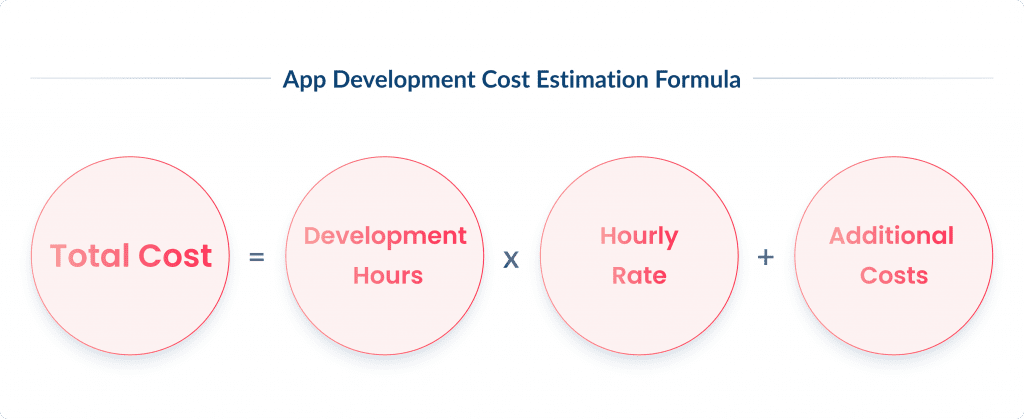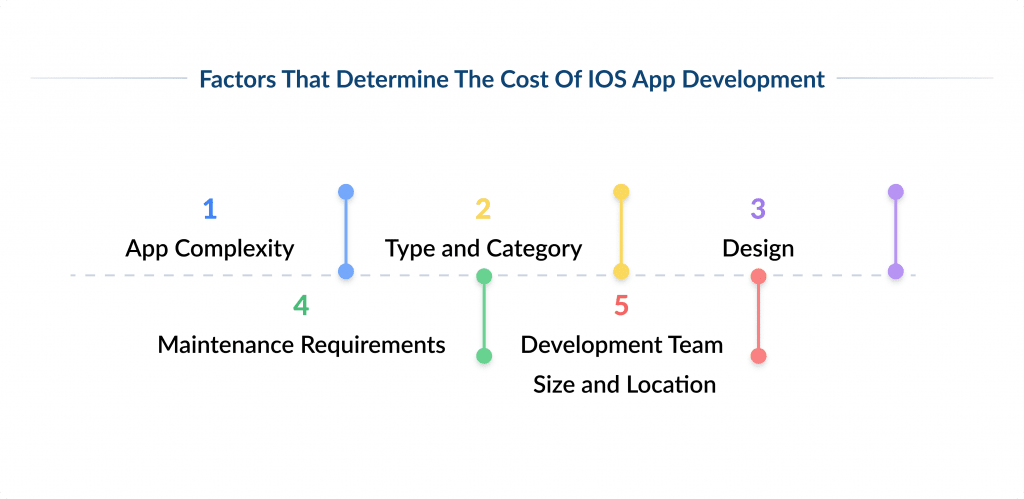How Much Does iOS App Development Cost in 2025?
- Updated: Nov 12, 2024
- 12 min
Have you ever wondered how much time people spend on their favorite mobile apps?
According to the DataReportal, smartphone users spend about 4.37 hours daily using mobile apps.
In 2025, the digital landscape is more vibrant than ever, with mobile apps playing a pivotal role in our daily lives.
Businesses across the globe are investing heavily in mobile technology to stay competitive.
According to Statista, the global mobile app market revenue hit a staggering $935 billion in 2023. And is only going to grow.
If you’re considering developing an iOS app, you need to understand the costs involved to make informed decisions and plan your budget effectively.
In this article, we’ll break down the various factors that influence the cost of developing an iOS app in 2025.
After reading this article, you will get a clear picture of what to expect and how to optimize your iOS app development project.
Ever wondered how to keep your customers coming back? Discover how car wash app development can help you create a seamless experience that keeps them happy and engaged.
Explore our app development services today
The Formula for Estimating iOS App Development Costs
When estimating the cost of developing an iOS app you need to keep in mind several key variables. This will help you create a more accurate budget for your project.
Here’s a formula to help you estimate the costs:
Total Cost = (Development Hours) x (Hourly Rate) + Additional Costs 
Let’s break down each component.
1. Development Hours
This is the total number of hours required to complete the app development. It includes:
- Planning and Research. Time spent on market research, defining requirements, and project planning.
- Design. Time spent on creating wireframes, UI/UX design, and prototypes. See how to outsource UI/UX design.
- Development. The time app developers spend coding, including front-end and back-end development.
- Testing. Time spent on quality assurance, bug fixing, and user testing.
- Deployment. Time spent on preparing and submitting the app to the App Store.
2. Hourly Rate
The hourly rate can vary based on the location, expertise, and reputation of the dedicated development team.
For instance:
| Location | Rates |
| US and Canada | $100 – $150 per hour |
| Western Europe | $70 – $120 per hour |
| Eastern Europe | $40 – $80 per hour |
| Asia | $20 – $50 per hour |
We’ll explore this point in more detail further.
3. Additional Costs
These are the extra costs that might be involved in the app development process:
- App Store Submission. Apple charges an annual fee of $99 for developers to list their apps on the App Store.
- Third-Party Services. Costs for using APIs, cloud migration discovery phase services, payment gateways, etc.
- Maintenance. Ongoing costs for updates, bug fixes, and improvements post-launch.
- Marketing. Costs for promoting the app to reach a wider audience.
iOS App Cost Calculation Example
Let’s say you’re developing a simple iOS app MVP with the following estimates:
- Development Hours: 1,000 hours
- Hourly Rate: $40 (Ukraine)
- Additional Costs: $10,000 (including App Store fees, third-party services, and initial marketing)
Using the formula:
Total Cost = (1,000 hours) x ($40/hour) + $10,000 = $50,000
Adjust the variables based on your specific project needs to create a more tailored budget.
You can also use our app development calculator to estimate the app development cost more accurately.
Now, let’s dive deeper into factors and variables that affect app development pricing.
We will cover app complexity, type, design, maintenance requirements, development team, and location.
Let’s go!
Key Factors Influencing iOS App Development Costs
One thing we would like to point out is that developing an iOS app is a significant investment for any business.
Before you sign an agreement with the app development vendor, you need to understand the factors that influence development costs.
This will help you make informed decisions and plan your budget.
According to a report from Clutch, the average cost of app development projects is $90,780.
The final price will depend on app complexity, feature set, and team location.
Let’s explore these factors that influence iOS app development costs further.
App Complexity Levels
Apps can be broadly categorized into three levels of complexity:
1. Simple iOS Apps
A basic iOS app has simple functionality. Such as a single platform, simple UI, basic controls, and minimal data processing.
- Examples: calculator apps, note-taking apps, etc.
- Development Time: typically takes 2-3 months.
- Cost Impact: low because of the straightforward development and minimal feature set.
2. Moderate Apps
Features include integration with APIs, more sophisticated UI, backend server support, database integration, and third-party services.
- Examples: social media apps, e-commerce apps, etc (Looking to launch an eCommerce business? Check out these eCommerce startup ideas for fresh inspiration.).
- Development Time: 3-6 months are needed to develop such an app.
- Cost Impact: medium because the complexity is higher, and there is a need for more extensive testing and development.
3. Complex Apps
A complex app has advanced functionalities. These can be real-time user interactions, custom animations, extensive backend requirements, high-end security, multi-language support, and AI features.
To navigate the world of AI, it’s important to know the language. Our AI glossary offers concise explanations for key terms.
- Examples: on-demand service apps, large-scale enterprise apps, etc.
- Development Time: from 6 months to a year or more.
- Cost Impact: high, because extensive resources are needed, as well as more expertise and time required.
App Types and Categories
Different types of apps require different levels of effort, technology, and expertise.
The graph below shows App Store market share percentages for the 10 most popular categories in 2025. 
1. Utility Apps
Focus: perform specific, simple tasks.
Examples: weather apps.
Cost Impact: generally low, as they are straightforward and require minimal development.
2. Gaming Apps
Focus: high interactivity, complex graphics, and often require advanced programming for game mechanics.
Examples: puzzle games and action games.
Cost Impact: high due to the need for high-quality graphics, sound effects, and advanced coding.
3. E-commerce Apps
Focus: user accounts, secure payment gateways, product listings, and order management systems.
Examples: Amazon, eBay.
Cost Impact: medium to high. The cost impact depends on features like user personalization, recommendation engines, and integration with third-party services.
Check out how to build an e-commerce app.
4. Social Networking Apps
Focus: user profiles, messaging, notifications, and real-time interactions.
Examples: Facebook, Instagram.
Cost Impact: high due to the need for real-time data processing, high security, and extensive database management.
In this article, we break down how to create an app like Instagram.
5. Enterprise Apps
Focus: streamline business processes, integrate with enterprise systems, high security.
Examples: CRM systems and ERP apps (learn more about ERP software development).
Cost Impact: very high because of complex integrations, custom and complex features, and high-level security.
Another factor that can influence app development costs is app design. Let’s break it down.
App Design
The design of an app is a part of digital design services and it includes user interface (UI) and user experience (UX).
The quality and sophistication of the design can also significantly affect development costs.
1. UI/UX Design
Simple design is basic and functional, with standard UI elements.
The complex design incorporates custom graphics, animations, transitions, and highly interactive elements.
The more complex the design you need, the higher the final cost to expect.
2. Prototyping and Wireframing
With prototypes and wireframes, you get a clear understanding of the app’s structure and functionality.
The initial investment into this stage can actually reduce costs and minimize errors during development.
3. User Testing
A thorough testing helps to identify usability issues and improves overall user satisfaction.
Of course, there is an additional cost needed to conduct tests and make necessary adjustments. 
Maintenance Requirements
Maintenance
Post launch maintenance is key to the app being functional and relevant after it goes live on the App Store.
This involves:
- Bug Fixes and Updates
Regular updates to fix bugs, improve performance and add new features.
Cost varies depending on the frequency and complexity of updates.
- Compatibility Checks
To ensure the app is compatible with new iOS versions and devices.
- Server Maintenance
For apps with backend services.
Ongoing cost for server upkeep, security updates and scaling.
Learn about the most impactful cybersecurity trends to safeguard sensitive data and prevent breaches.
All the above factors are dependent on the development team size and location.
Let’s see the difference between working with a development team from Ukraine versus iOS developers from the US.
Development Team Size and Location
The team size and location has a big impact.
- Team Size
Small Team: Fewer developers means slower but more cost-effective.
Large Team: More developers means faster development but higher cost.
Cost Impact: Larger teams with more roles (developers, designers, testers) means more cost.
- Location
When selecting an app development team, you have a few options: hire iOS developers in-house, leverage IT outsourcing, or work with freelancers.
If you don’t know what is IT outsourcing, check out our handy guide.
Then, you need to choose where you want to hire talent from.
Is it offshore outsourcing, onshore, or nearshore?
Onshore specialists usually have higher app development hourly rates, better communication, and quality assurance.
Offshore developers have lower rates, but you need to choose carefully to avoid possible communication barriers and poor quality.
Read our top 10 countries for outsourcing research.
In summary, offshore is cheaper but requires more oversight.
Now let’s move on to the next point. Is it cheaper to build iOS app or Android app?
iOS vs. Android App Development Cost
According to Statista, as of 2025, mobile app development is a growing industry, and by 2026, it will reach $935 billion.
So many businesses are faced with the dilemma of choosing between iOS and Android for their app.
While each has its own advantages you need to know the cost implications to make a better choice.
Here are the key points to consider when comparing iOS and Android development costs.
Development
iOS development is faster and can be cheaper as there are fewer devices and os versions to support.
A report by Business of Apps states that the average cost to develop an iOS app is from $30,000 to $150,000+.
Android development takes more time and resources as there are more devices and screen sizes.
This can lead to higher development costs, with the same report suggesting Android app development cost can range from $40,000 to $200,000+.
Design
iOS design is simpler as Apple has strict design guidelines. This is to ensure consistency across devices.
Android, with its many devices and manufacturers, requires more flexible and adaptive designs, which can add to design complexity and costs.
The need to accommodate different screen sizes and resolutions in Android design adds to the workload and expense.
QA and Testing
QA and testing for iOS apps is easier as there are fewer devices and os versions to test against.
This means cheaper.
For Android, there are more devices and versions, so more testing is required to ensure compatibility and performance.
This means higher costs.
TechBeacon says QA and testing can take up to 30% of the total budget and this can be higher for Android apps.
Launch Strategies
To launch an iOS app, you need to follow Apple’s rules.
It means longer review times but a more controlled quality check.
According to Appl,e the average review time for an app in the Apple app store is 1-2 days.
Android apps have shorter review times and more flexible guidelines with Google Play reporting an average review time of a few hours to a day.
The Android platform is considered “fragmented” because it’s used on many devices with different screen sizes, hardware specs, and OS versions.
This fragmentation can be a challenge for app developers who need to make their apps work on all these devices.
Imagine you have a new game app. The game works perfectly on iPhones which are all very similar in terms of hardware and software.
But on Android some users with older phones or different screen sizes will have issues like crashes or the game not displaying correctly.
To fix these problems, you might need to update the app frequently, respond to user complaints, and maybe even spend money on ads to assure users that the issues are being fixed.
So, while developing for Android can get you to a bigger audience, it requires more work to make it consistent and good across all devices.
These differences will impact your launch costs and strategy.
Let's shape your startup's product vision together!
Strategies to Reduce iOS App Development Costs
As you can see, developing an iOS app can be a costly endeavor.
However, there are several strategies that businesses can employ to reduce development costs without compromising on quality.
Let’s explore these strategies further.
1. Clear and Detailed Requirements
The first thing you need to do when developing an iOS application is to clearly outline the app’s features, functionalities, and design elements.
This helps avoid scope creep, which can lead to increased costs and extended timelines.
For the initial release, you should focus on essential features.
Based on user feedback and business needs, future updates can add additional features.
For example, a telehealth app must-have functionalities can include patient tracking, appointment scheduling, EHR capabilities, and security.
Curious about the impact? Here’s a look at the benefits of electronic health records for healthcare teams and patients.
2. MVP Approach (Minimum Viable Product)
Start small: Develop a basic version of the app with core features to test the market.
This reduces initial costs and allows for early user feedback.
In fact, many successful companies test their business idea with an MVP in software development.
Did you know that Dropbox initially launched with a basic file-sharing and storage feature?
This MVP allowed them to gather user feedback and scale their services based on user needs, initially saving costs on unnecessary features.
3. Use of Pre-built Components
You can also use third-party libraries, APIs, and frameworks to save time and development costs.
These pre-built components can provide the functionalities you need without more expensive custom development.
4. Cross-Platform Development
Consider using cross-platform development frameworks like React Native or Flutter to build apps for both iOS and Android.
By the way, the popular travel app Airbnb was developed using React Native.
React Native app development cost will be lower and this can allow your company to deploy your app on both iOS and Android platforms simultaneously.
Here’s a look at the best iOS app development tools for creating standout mobile apps.
5. Optimize Design Process
Develop wireframes and interactive prototypes to visualize the user flow and design before development begins.
This helps to identify potential issues early and reduce rework.
Keep your design consistent across the app as it simplifies development and testing processes.
You can use tools like Sketch and InVision to create wireframes and prototypes.
This helps stakeholders visualize the app’s functionality and design, making identifying and fixing potential issues easier before full-scale development begins.
6. Efficient Project Management
Agile project management practices can help ensure flexibility, continuous improvement, and efficient resource utilization.
You need to communicate clearly and consistently with the development team to ensure everyone is aligned with the project goals and timelines.
In our software development lifecycle, we use an agile discovery process.
Regular sprints and iterations allow us to adapt to changes quickly and keep development costs under control.
For efficient task handling, here are the best project management software options available today.
7. Hire the Right Team
Did you know that investing in skilled and experienced development teams potentially reduces long-term costs?
Consider outsourcing development to regions with lower labor costs. But first, you want to ensure the quality of their work.
Explore their case studies and client reviews, conduct interviews, and give them a test task to see if your visions align.
Check out our guide on hiring developers to learn more.
8. Testing and Quality Assurance
No one wants to use a laggy app.
Use continuous integration and continuous deployment (CI/CD) pipelines to streamline the development and testing process.
If you build a complex app and manual testing is not an option, you can implement automated testing to quickly identify and fix bugs. 
9. Post-Launch Strategies
Your iOS app is designed, developed, tested, and launched; what’s next?
The maintenance!
Regular maintenance and updates keep the app functional and relevant.
This can prevent costly major overhauls in the future.
You want to actively gather and analyze user feedback and make informed decisions on updates and new features.
Let’s take, for example, a ride-sharing app like Uber.
They regularly collect user feedback through in-app surveys and app store reviews.
Then, they use this feedback to prioritize updates and new features, focusing on what users value most.
This helps them maintain user satisfaction and reduce unnecessary feature costs.
Use our app development calculator to estimate app cost.
Why Choose SpdLoad for iOS App Development?
Planning to build an iOS app in 2025?
We’ve got you!
Whether you need a simple or a more complex app with advanced features – our iOS developers are here for you.
You can count on our expertise, 10+ years of app development experience, and transparent communication practices.
We will utilize the best iOS development tools, keeping your vision and business growth in mind.
Be sure we’ll implement the most scalable and user-friendly features to help your startup grow quickly and organically.
If you are looking for tech startup ideas, make sure you check out our recent article, which explores the most profitable ventures.
Ready to get started? Contact us now, and we will schedule a brief intro meeting to discuss the project details.













